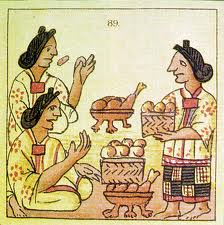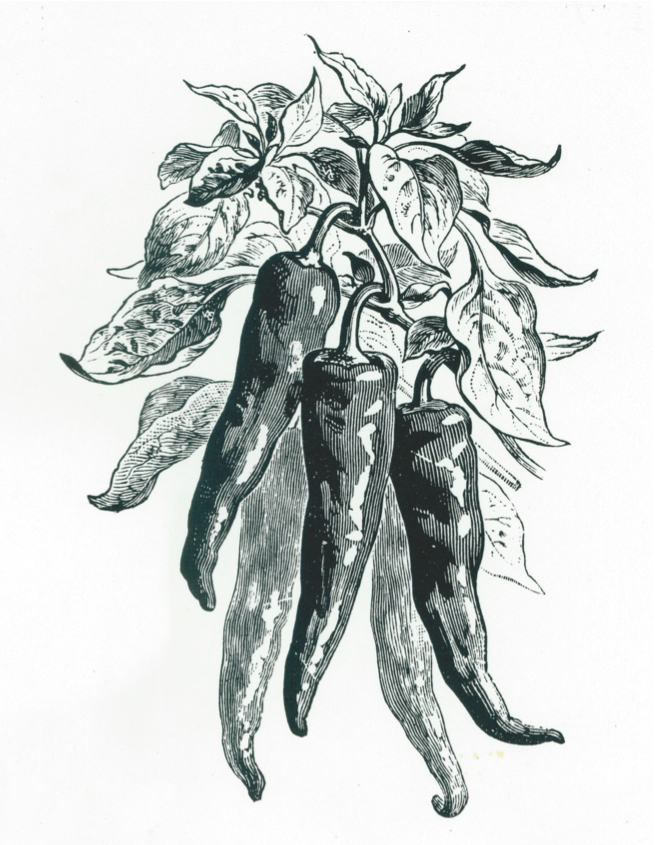By William English Carson

If a stranger is content to embark on a course of Mexican food and can stomach the highly seasoned dishes, filled with chilis and red peppers, he can get satisfactory meals at the Mexican restaurants, for some of the things which are served are piquant and excellent. But he must beware, for the dishes have a nomenclature all their own, and one can blunder badly. Therefore, unless the head waiter can explain the composition of the various strange dishes, the uninitiated guest is in danger of being served with some very unappetizing messes, reeking with grease and filled with red peppers, chilis and other fiery condiments.
Of the foods most popular among Mexicans mention must be made of chili-con-carne (chilis with minced meat), which is very palatable, although hot. Tamales, another favorite dish, are made of chopped meat, highly seasoned with pepper and chilis, wrapped in a corn husk and boiled quickly. Sometimes a tortilla is used as a wrapping, and the tamale is cooked in boiling fat. Enchiladas are something like tamales, but are seasoned with Mexican cheese and onions and soaked in chili sauce. Frijoles (par excellence the Mexican national dish), a vegetable equivalent to the roast beef of old England, are black beans boiled, then fried in lard and served reeking with grease. As such cooking is quite unsuited for a hot climate, it is not surprising to find that diseases of the stomach and liver are almost universal among Mexicans. At the cost of a few cents, enough frijoles can be bought to feed a family for a day. Few householders furnish their servants with any other food than tortillas and frijoles.
Eggs (huevos) in various forms are served at every meal, a plain omelette being called a tortilla natural or tortilla de huevos. Cocidas are a concoction of potatoes chopped in small pieces, beetroot, carrots, small pieces of meat, maize and cauliflower, all boiled together. A salad of cold sliced tongue, chopped olives, celery and lettuce, with mayonnaise dressing, is very popular. Stewed or roast chicken served with rice, highly seasoned, called arroz con polio, figures on every bill of fare.
Roast beef is served in every style, always with some highly seasoned sauce, and is sometimes actually smothered with raisins. The meats, as a rule, are fresh, but generally stringy and tough, due to the fact that the grazing is poor, and that meat, on account of the heat, must be eaten very fresh. The same quality is noticeable in the poultry, which is always tough, as it is never allowed to hang long enough. In cutting up meat the butchers never disjoint the carcasses, but cut the flesh off in strips.
Fresh vegetables are not obtainable in Mexican hotels and restaurants as largely as they ought to be, and during the winter season American and French canned vegetables are chiefly used. There is no excuse for this, as vegetables of all kinds can be grown the year round in most parts of Mexico. On the other hand, fresh fruits are plentiful, such as apples and peaches from the temperate zone, and pineapples, oranges and bananas from the hot country. One of the most interesting fruits is the aguacate [avocado], which resembles an enormous green pear, the inside of which is like butter, is almost tasteless, and is frequently used as a natural salad dressing.
Bread and rolls are invariably good. The native butter is usually uncolored and unsalted and has very little flavor, but is only served in the best establishments, American butter or oleomargarine being more extensively used. Milk, as a rule, is rather poor and watery, but an excellent cream cheese is made in some parts of the country.
There are very few native drinks which are palatable to foreigners. The ill-tasting pulque is not drunk by the better-class Mexicans or served in the restaurants. French, Italian and Spanish wines and German beers can be had at most of the better-class establishments, and here and there the order “Cerveza de Milwaukee” will be understood. Some very fair light lager beer, brewed by German firms at Monterey and Toluca, is a very popular drink. There are also several native mineral waters, of which the best known is Topo Chico, derived from a spring of the same name near Monterey. The indolence of the Mexicans is solely to blame for their having no native wines, for excellent grapes will grow well all over the country. This is another instance of the Mexican being governed by habit. Wine-making was prohibited by the Spaniards in the interests of the wines imported from the mother country, and as the Mexican has not made wine for four hundred years, he cannot see why he should begin now.
 Of course, all Mexicans love coffee, but as a rule the coffee grown and served in Mexico is very strong, with a drug-like bitterness, partly due to the bean being too much roasted.
Of course, all Mexicans love coffee, but as a rule the coffee grown and served in Mexico is very strong, with a drug-like bitterness, partly due to the bean being too much roasted.
From: Mexico, The Wonderland of the South. New York: The Macmillan Company, 1909.









